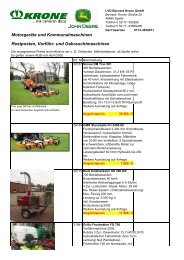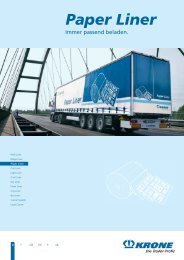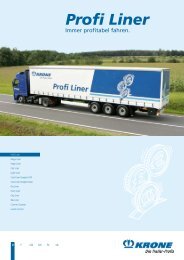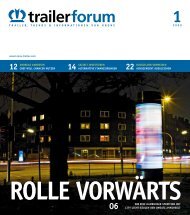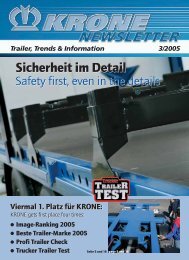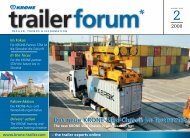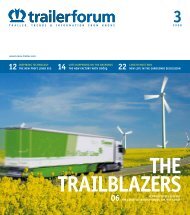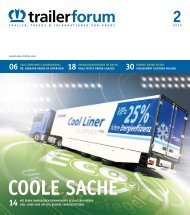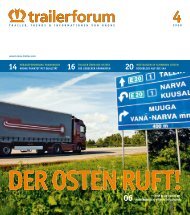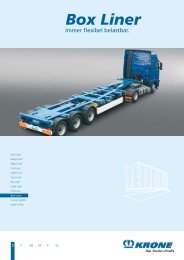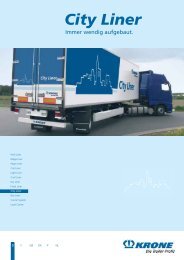Quo vadis, traffic?
Quo vadis, traffic?
Quo vadis, traffic?
Erfolgreiche ePaper selbst erstellen
Machen Sie aus Ihren PDF Publikationen ein blätterbares Flipbook mit unserer einzigartigen Google optimierten e-Paper Software.
REPORT | REPORT<br />
Staugefahr verspricht. Die Nachrichten im Autoradio<br />
vermelden eine Kollision zweier Satelliten. Wer hätte im<br />
Jahr 2006 gedacht, dass wir gut zehn Jahre später auch<br />
noch mit Stau im Weltall zu kämpfen haben. In der Studie<br />
von acatech war davon jedenfalls nichts zu lesen.<br />
// This is the year 2020. During the morning drive to<br />
work; our navigation unit cleverly avoids all <strong>traffic</strong><br />
jams. The data of the current road situation are received<br />
from outer space, for – as planned – the first<br />
European satellite navigation system Galileo replaced<br />
the former US system GPS in 2010. The daily radio<br />
messages about <strong>traffic</strong> jams make us think back to<br />
the year 2006 …<br />
FUTUROLOGY<br />
This trip into the future is fictional. But some details<br />
of it may become true. The “Union der Deutschen Akademien<br />
der Wissenschaften“ (acatech) in a current<br />
study titled “Mobility 2020 – perspectives for tomorrow’s<br />
<strong>traffic</strong>” forecasts the extent and limits of <strong>traffic</strong><br />
in Germany. Their conclusion: more <strong>traffic</strong>! But this is<br />
only half the truth – as it is inexact. Precisely, the researchers<br />
forecast a plus of 34 percent for lorry <strong>traffic</strong><br />
for the period 2002 to 2020, for rail cargo <strong>traffic</strong> they<br />
even forecast an increase of 55 percent. With 20 percent,<br />
car <strong>traffic</strong> is third in the statistics. Where there<br />
were three lorries in 2002, there will be four 18 years<br />
later; a <strong>traffic</strong> jam of 200 cars will cause 240 drivers<br />
to stand still in 2020, and who lives near a railway<br />
line will hear twice as many cargo trains roll past.<br />
VERKEHR UND INFRASTRUKTUR IN<br />
DEUTSCHLAND IN ZAHLEN (STAND: 2006)<br />
TRAFFIC AND INFRASTRUCTURE<br />
IN GERMANY IN FIGURES (EX: 2006)<br />
Bundesfernstraßen / Federal highways 53.183 km<br />
Bundesautobahnen / Federal motorways 12.044 km<br />
Bundesstraßen / Federal roads 41.139 km<br />
Anzahl Pkw / Number of cars 46,1 Mio. million<br />
Anzahl Lkw / Number of lorries 2,6 Mio. million<br />
Anzahl Binnenschiffe (2004)<br />
Number of inland navigation vessels (2004)<br />
3.616<br />
Anzahl Luftfahrzeuge (2004)<br />
Number of aircraft (2004)<br />
19.956<br />
Quelle: Statistisches Bundesamt Deutschland<br />
Source: Federal Statistical Office Germany<br />
REGIONAL DIFFERENCES<br />
More <strong>traffic</strong>; but the researchers do not give this<br />
slogan for any place in equal measure. While a strong<br />
<strong>traffic</strong> growth is expected for the areas of Hamburg,<br />
the Ruhr area, Frankfurt/Main, Mannheim, Stuttgart/<br />
Karlsruhe, and Munich, the institution, deliberately<br />
called after the combination of academy and technology,<br />
assumes stagnation or even a decrease of <strong>traffic</strong><br />
in the New Laender. Exception: Berlin and its<br />
surroundings. Accordingly, professor Franz Pischinger,<br />
leader of the “Mobility 2020“ project, demands:<br />
“We want to show that a demand-oriented promotion<br />
of road and rail is badly needed.”<br />
DIVERSION REQUIRED<br />
Exactly – for making up the balance and forecasting<br />
alone does not change anything – a solution is<br />
urgently required: That’s why acatech, in 2006, proposes<br />
two models for diverting our course in future –<br />
away from what in the end will certainly lead to the<br />
collapse of <strong>traffic</strong>. One model for financing the highway<br />
infrastructure envisages the partial replacement<br />
of vehicle and fuel taxes by a road royalty. A second<br />
proposal aims at continuing to finance the road<br />
<strong>traffic</strong> infrastructure projects by the Government. In<br />
this case, however, part of the tax income should be<br />
fixed for these projects.<br />
CITY CENTRES WITHOUT LORRIES<br />
Another attempt to get the growing <strong>traffic</strong> under<br />
control is e.g. named “environment badge” – German<br />
cities let lorries drive through depending on the current<br />
particulate matter content in the air. Cities as<br />
London or Stockholm try to keep the cars out of the<br />
city centre by means of a toll. But also politicians<br />
have means to prepare the way for <strong>traffic</strong>. Thus the<br />
“Bundesverkehrswegeplan 2003” (federal <strong>traffic</strong> route<br />
plan 2003) provides a financial volume of about 150<br />
billion Euros for the three transport ways rail, road,<br />
and waterway for the period of 2001 to 2015. About<br />
83 billion Euros are just planned for the maintenance<br />
of the existing infrastructure and about 66 billion<br />
Euros for new projects and extensions.<br />
TRAFFIC JAM IN OUTER SPACE<br />
Back to the future: it is closing time in the year 2020.<br />
We are driving home on the route with as few <strong>traffic</strong><br />
jams as possible, due to the satellite-based navigation<br />
system. Radio news reports the collision of two satellites.<br />
Who, in 2006, would have thought that there<br />
would be <strong>traffic</strong> jams even in outer space? Nothing<br />
could be read about this in the acatech study.<br />
30 trailerforum 3/2006




